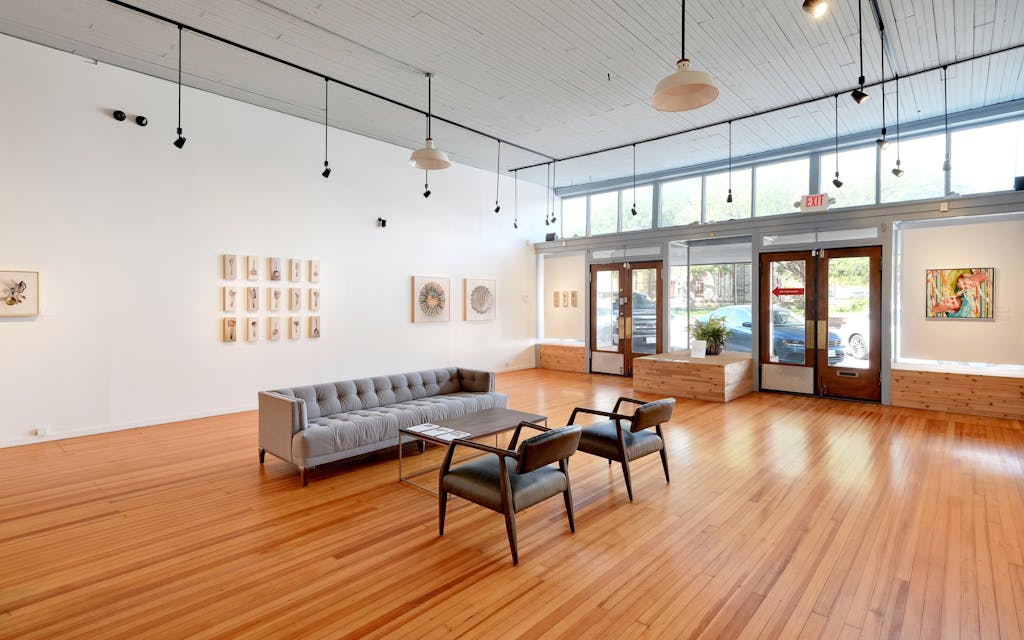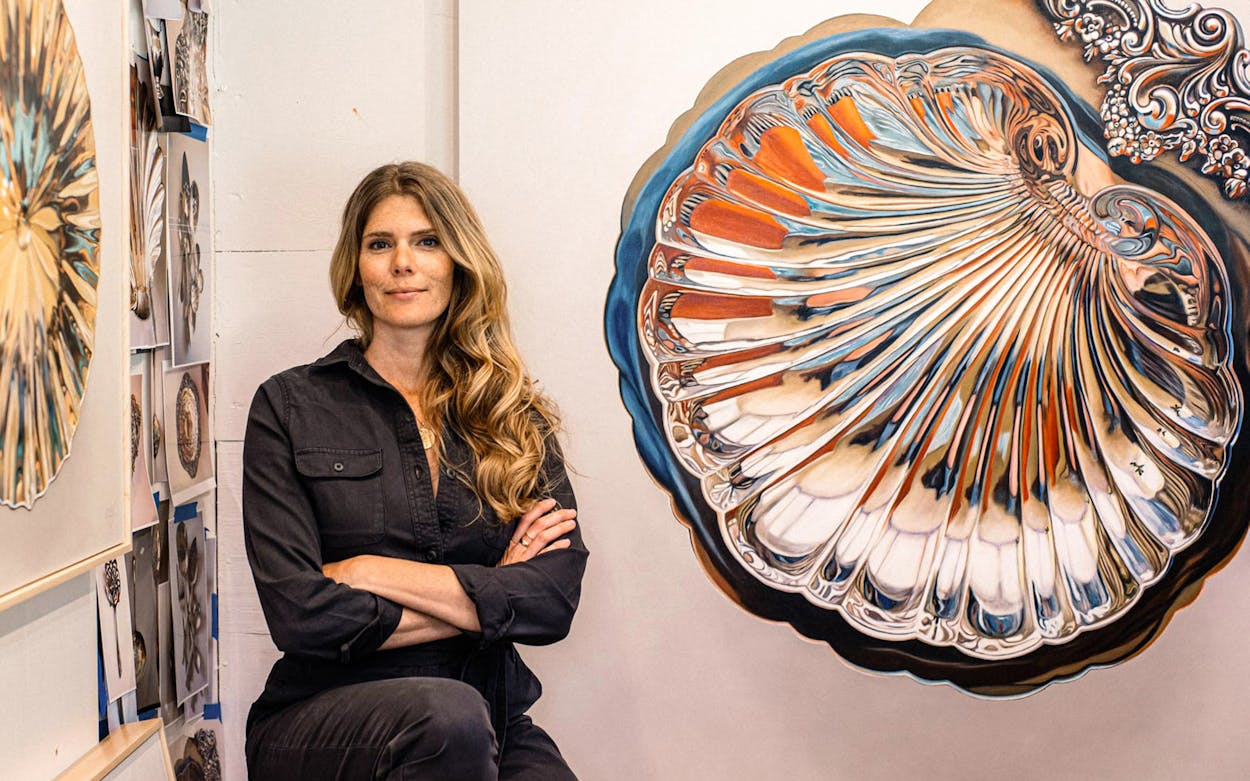It’s First Friday in Lockhart, a night when merchants keep their shop doors open late and live music blares from a stage on the town square. The area is dotted with food and vendor booths for the night. As barbecue smoke wafts through the warm early-May air, the crowd is abuzz; we spot two little girls laughing and dancing on the Caldwell County courthouse lawn. My husband and I, newly vaccinated and having just left our son with a sitter for the first time in over a year, feel almost euphoric at the prospect of strolling the square, ducking into art galleries, and then eating dinner at a sidewalk cafe.
We walk toward Commerce Gallery, our first stop of the evening, for Leslie Lewis Sigler’s new show, “Familiar.” It’s a personal and professional homecoming for the Texas-born and -raised artist, who has called California home since 2006. Sigler has shown her work in galleries on both the East and West Coasts, but now her first gallery show in her home state is just eighteen miles from San Marcos, where she grew up. Inside the gallery, a former boot shop, some visitors are wearing masks and others are maskless. “I’m vaccinated now,” I overhear, as people lean in for hugs.
This phase of the pandemic—combined with Lockhart’s recent reinvention as a stylish town with boutique hotels, shops, and restaurants, but one that still holds on to its cowboy roots—feels like the ideal setting for an artist exploring themes of belonging, separation, and reconnection through her work. “Familiar,” which runs through June 27, presents a collection of Sigler’s contemporary oil paintings of silver family heirlooms—think trays, pitchers, and flatware—rendered in painstaking realistic detail.
Sigler’s fascination with silver objects began in her early twenties, when her grandmother, the family matriarch who lived in nearby Wimberley and brought everyone together around the table, started giving pieces from her silver collection to the artist for her birthday. One year, Sigler received a spoon with her great-grandmother’s monogram; another year, a silver butter dish. These gifts sparked curiosity about the inherited pieces, the lives they had lived, and the conversations, celebrations, and marriages they had been part of.


The outlines of objects Sigler paints are crisp and tightly rendered. Silver Spoon #199, The Cowboy, a small painting at seven by five and a half inches, could at first glance easily be mistaken for a photograph of an antique pierced serving spoon with scalloped edges. Minute details of the handle’s pattern, plus the contrast between light and dark with shadows falling around the spoon, make it appear almost three-dimensional, as though you could grab it off the canvas and dip it into a jelly jar. But a closer look reveals brushstrokes in the bowl of the spoon, where the reflections take on a turquoise hue. Where does this color come from? The button-down shirt Sigler wore as she painted the spoon? Perhaps there were turquoise curtains nearby. These subtle surprises reward viewers who pay close attention.
Sigler began painting her own family’s silver in 2011, starting small with flatware at first. From experimentation with abstractions in the bowl of a spoon, the artist moved on to painting large platters. At sixty by sixty inches, The Legend is the largest portrait she’s painted to date, depicting a silver scalloped candy dish. In a short video describing the origins of her work and the steps in her process, Sigler recounts a story about a tea set that started her on the path to finding and depicting life in inanimate silver heirlooms. After seeing the silver set displayed at a friend’s house, she asked to borrow the dishes so that she could photograph and then paint them. “I noticed the objects in the set looked a lot like a family. The coffee and the teapot looked like two parents, and the creamer and the sugar looked like two kids,” Sigler says. “I started to see this family object as a family of objects.”
Sigler’s own extended family still lives in Texas. She graduated from San Marcos High School in 2001 and then from UT-Austin in 2006 with bachelor’s degrees in design and studio art. In her studio art classes, she fine-tuned skills like color mixing, which she uses to render realistic-looking metal objects on canvas. “It was literally about learning how to see colors and mix colors,” Sigler says. “One day in a studio art class, I was squeezing yellow paint from a tube, and my professor said, ‘Do you really see yellow in that reflection?’” She didn’t. “Paint the colors you see,” the professor advised. During Sigler’s senior year at UT, her subject was a pair of shiny red boxing gloves, an early project in thinking about inanimate objects as lifelike portrait subjects and honing the skills needed to paint mini abstractions in the reflections of her subjects.

A mother of two, Sigler says that her hours in her Soquel, California, home studio are bracketed by the beginning and end of the school day. She says her process shifted before she became pregnant with her first son. When working on a series called Matriarchs, Sigler was rendering a pitcher. As she often does, she began to personify the objects as she studied them closely. “I loved the way the handle of a pitcher looked like a mother sort of standing with her hand on her hips,” Sigler recalls. “She was a voluptuous water pitcher, like the Madonna—or maybe that was just my subconscious wanting to become pregnant.” Now that her sons are four and six, Sigler says motherhood has changed the way she approaches her work. “I used to polish silver to perfection before I painted it. Now I photograph the object in its current state, then polish and photograph it, then let it tarnish and photograph it again so it has a sort of bronzy finish. As I’ve grown a family, I’ve embraced imperfection.” That shows in the patina of pieces from the “Familiar” show. In The Others, four silver serving pieces are jumbled together, each piece reflecting polish as well as tarnish and patina.
During the pandemic, Sigler felt especially isolated since she couldn’t fly home to see her family. “I’ve seen more and more the importance of family and the connections to family in my work as I’ve been raising my sons away from my family in Texas,” she says. Referring to her Silver series, individual small portraits of flatware and serving pieces displayed in a grid at Commerce Gallery, Sigler says, “I looked around my studio and saw all these objects alone, and I thought, ‘They’re lonely. I’m lonely.’ I had this longing to be in a crowd of people I love. So I thought, ‘How can we break the rules and be together? Let’s break the rules and put them all in a crowd.’” That led to paintings including “The Familiar,” a group of silver serving pieces that looks like the result of someone overturning a silverware drawer. Juxtaposed with her portraits of individual spoons, cake servers, and soup ladles, “The Familiar” is chaotic. Look closer, and you’ll see a pair of spoons, well, spooning, seemingly enjoying closeness after separation.
The crowd gathering at Commerce Gallery the first Friday in May is also a little chaotic and familiar. I overhear a woman commenting that one of the paintings is an exact match of her grandmother’s silver pattern. Sigler says at other shows, viewers often tell her that the portraits conjure long-forgotten recollections of the childhood chore of polishing silver before a family holiday meal. She likes knowing that her work dredges up old memories. “That’s what I’m doing in these paintings,” she says. “I’m honoring these objects because we inherit them, and sometimes they’ve been sitting in a chest or a dark closet for a long time.”
- More About:
- Art
- San Marcos
- Lockhart






